

Human/AI hybrids and gene editing are going to change mankind in a big way. The human race has come a very long way in a short amount of time, but what is coming around the corner will change everything we thought we knew about mankind.
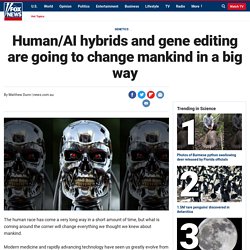
Modern medicine and rapidly advancing technology have seen us greatly evolve from the early days of hunter-gatherers, and now the same factors are working toward seeing the introduction of “superhumans” into our society. At the core of the development is designer bodies using DNA manipulation and human/AI hybrids, both of which were highlighted during the World Government Summit in Dubai. Imagine being able to choose if your unborn child will be male or female, their height, weight and even athletic prowess. Now imagine hacking our memories or making our bodies able to thrive in extreme environments in which survival was previously impossible. These are both quickly becoming a reality, according to founding director of the Life Sciences Project at Harvard Business School, Juan Enriquez. This story originally appeared in news.com.au. Scientists Have Discovered This Drug Fixes Cavities and Regrows Teeth.
In Brief A new discovery about a drug developed for Alzheimer's patients might replace fillings for cavity repair.

Tideglusib stimulates stem cells in the pulp of teeth, promoting new dentine production and natural tooth repair. These High-Tech Glasses Will Give You Superhuman Vision. In Brief Researchers have designed filters that allow the human eye to distinguish between color hues that are ordinarily too close to tell apart.
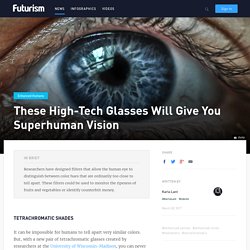
These filters could be used to monitor the ripeness of fruits and vegetables or identify counterfeit money. Tetrachromatic Shades It can be impossible for humans to tell apart very similar colors. But, with a new pair of tetrachromatic glasses created by researchers at the University of Wisconsin-Madison, you can never again leave the house wearing two items of black clothing that don’t quite match. These spectacles enhance the user’s existing color vision, affording them new power to discern more distinct shades. Color vision in humans relies on short, medium, and long types of cone cells reacting to blue, green, and red wavelengths of light, respectively. “They look exactly the same and you look through the spectacles and, holy crap, they’re two different things,” Kats said in an interview with New Scientist.
DARPA: We're Moving to Merge Humans and Machines. If You Can’t Beat Them… Without a doubt, computers and machines are besting humans in many ways thanks to developments in artificial intelligence (AI).

AIs have beaten their human counterparts at everything from games like Go and poker to driving safely and treating illnesses. Clearly, intelligent machines are increasingly becoming better than humans at so many things, and as the old saying goes, if you can’t beat them…merge with them. Given that AI is expected to surpass humankind at an unprecedented rate, that just might be the best thing we can do, and it’s the idea behind Elon Musk’s neural lace, an unconventional and highly controversial brain-computer interface. World's First Human Head Transplant Edges Closer To (Virtual) Reality. Worse Than Death?

Last year, Italian surgeon Sergio Canavero announced he is conducting the first human head transplant on Valery Spiridonov, a Russian man with muscular atrophy, in 2017. He hopes to perform the surgery in the UK, if they will let him. Last year, Hunt Batjer, president of the American Association for Neurological Surgeons, said that if the procedure works, Spiridonov could experience something far worse than death. “I would not wish this on anyone,” he said. This man is planning to receive a human head transplant in 2017. Russian Man Will Become Subject Of First Human Head Transplant Ever Performed. Neurosurgeon to attempt world's first head transplant.
An Italian neurosurgeon has unveiled plans to perform the first human head transplant by the end of 2017.
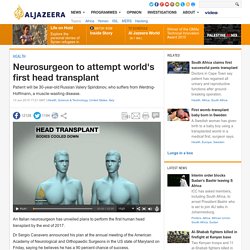
Dr Sergio Canavero announced his plan at the annual meeting of the American Academy of Neurological and Orthopaedic Surgeons in the US state of Maryland on Friday, saying he believes he has a 90 percent chance of success. He said his patient will be a 30-year-old Russian man, Valery Spiridonov, who has the muscle-wasting disease, Werdnig-Hoffmann. "Of course there is a margin of risk, I cannot deny that," Canavero said. "I made the announcement only when I was pretty sure I could do it. " Both men, who have been in regular contact through video chats, believe the controversial procedure is Spiridonov's best hope, the Reuters news agency reported. "If it goes good, I think I will get rid of the limits which I have today and I will be more independent and this will much improve my life," Spiridonov said. First human head transplant could happen in two years - health - 25 February 2015.
Read full article Continue reading page |1|2 A radical plan for transplanting a head onto someone else’s body is set to be announced.

But is such ethically sensitive surgery even feasible? IT'S heady stuff. Human Head Transplants Could Become A Reality By 2017. Head transplants, or body transplants depending on how you look at them, are not just a thing of quirky horror movies.
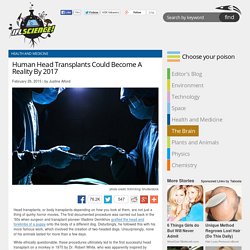
The first documented procedure was carried out back in the ‘50s when surgeon and transplant pioneer Vladimir Demikhov grafted the head and forelimbs of a puppy onto the body of a different dog. Disturbingly, he followed this with his more famous work, which involved the creation of two-headed dogs. Unsurprisingly, none of his animals lasted for more than a few days. Is it Possible to Transfer your Consciousness from One Body to Another? The idea of being able to completely transfer your mind from one brain to another sounds like something straight out of science fiction.

In fact, there are a couple of major movies that have broached the subject. Movies like The 6th Day from 2000, and more recently Selfless from 2015, both deal with the idea of being able to record and transfer your consciousness from one body to another. For starters, let’s talk about what our consciousness really is. Our current mental state is nothing but a series of memories, in essence. We remember experiences, emotions, and reactions that makes up who we are in our brains. 3D Printed Brain Tissue Has Arrived. In Brief Australian researchers have developed a novel method for constructing layered biological structures that looks just like cerebral cortex tissue using a handheld 3D printer.
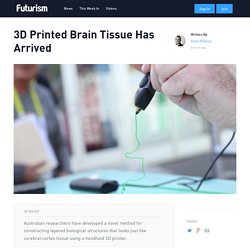
Neuroscientists rarely get the opportunity to study the human brain directly, and so work on cells or tissue slices that have been dissected from animals and grown in Petri dishes. How Tiny Lab-Grown Human Brains Are Giving Big Insights Into Autism - Singularity HUB. First came lab-grown mini-hearts. Then came 3D printed skin. Now scientists have taken “body on a chip” to a whole new level. Starting with skin cells from patient biopsies, scientists transformed them back into stem cells, and from those grew pea-sized, self-organizing, crazy-looking nuggets of living — yes, LIVING — brain.
These “cerebral organoids” are the brainchild of Dr. How Do Artificial Neural Networks Learn? This post was originally written by Manan Shah as a response to a question on Quora. The field of artificial neural networks is extremely complicated and readily evolving. In order to understand neural networks and how they process information, it is critical to examine how these networks function and the basic models that are used in such a process. What are artificial neural networks?
Artificial neural networks are parallel computational models (unlike our computers, which have a single processor to collect and display information). These networks are commonly made up of multiple simple processors which are able to act in parallel alongside one another to model changing systems. The basis for these networks originated from the biological neuron and neural structures – every neuron takes in multiple unique inputs and produces one output.
Swedish scientists create an artificial neuron that mimicks an organic one. Chemical-to-electrical-to-chemical signal transmission. A conventional neuron (upper panel) senses chemical signals (orange circles), which trigger an electrical pulse of membrane depolarization (action potential) along the axon, causing chemical release at the axon terminals (blue circles). This process can be mimicked (lower panel) by a chemical biosensor (for glutamate or acetylcholine) connected to an axon-mimicking organic electronic ion pump that transmits electrons/ions and generates chemicals — forming an organic electronic biomimetic neuron. (credit: Daniel T. Simon et al. /Biosensors and Bioelectronics. Scientists Grow Human Serotonin Neurons in Petri Dish - Futurism. In Brief For the first time ever, researchers have generated human serotonin neurons from human fibroblasts, the cells that give rise to connective tissue in the body.
Because obtaining live human serotonin neurons to study disease have been near impossible, almost all prior research has been done using lab animals. This research completely changes this paradigm by generating human serotonin in a petri dish.To produce the serotonergic neurons from fiberblasts, the team introduced four genes that typically control development. The result was neurons that were electrophysiologically active and demonstrate both the controlled release and the selective uptake of serotonin.Such induced serotonin neurons are extremely beneficial since they can be generated from individual patients suffering from illnesses involving the neurotransmitter.
Scientists create synthetic membranes that grow like living cells. Growing cell membranes are seen in this time lapse sequence (numbers correspond to minutes of duration) (credit: Michael Hardy, UC San Diego) Chemists and biologists at UC San Diego have succeeded in designing and synthesizing an artificial cell membrane capable of sustaining continual growth, just like a living cell.
Their achievement will allow scientists to more accurately replicate the behavior of living cell membranes, which until now have been modeled only by synthetic cell membranes without the ability to add new phospholipids. A Woman Has Been Given A New 3D Printed Skull. Face ready for Transplant. Researchers can now 3D-print nose cartilage in 16 minutes.
'We've Found a Cure for Baldness,' Says Japan's Shiseido. Scientists Grow Hair Using Stem Cells. For the first time, a team of U.S. scientists has developed a technique to convert human stem cells into a type of cell that is capable of initiating hair growth. When these cells were transplanted into mice lacking hair, they successfully induced human hair growth, suggesting that with further development, this method could lead to a cell-based treatment for people suffering hair loss. Could This Finally Be the Cure for Balding? - Futurism. Tooth Regeneration Gel Could Replace Painful Fillings. Growing Out New Teeth. Stem-Cell Dental Implants Grow New Teeth Right In Your Mouth. Bioengineering Missing Teeth. Imagine replacing a missing tooth, not with an implant or a bridge, but with a bioengineered one created from your gum cells.
Scientists Develop Telescopic Contact Lenses That Can Zoom 3X. Over the past year, we’ve heard about some pretty interesting developments in the world of contact lenses. Bionic Eye Successfully Implanted, Restores Sight To 80-Year-Old Man. Bionic eye. A Biotech Startup Wants To Replace Your Eyeballs With Synthetic Ones. Retinal Implants Restore Partial Sight To Three Blind. Bionic Eyes Can Already Restore Vision, Soon They'll Make It Superhuman. Stem Cell Treatment Successfully Restores Sight.
Bionic Eye Successfully Implanted, Restores Sight To 80-Year-Old Man - Futurism. Mayo Clinic patient's first impressions with bionic eye - Futurism. Robo-Eye to Enter US Market. Superhuman Vision Is Possible With Terminator-Like Contact Lenses. Inject Your Eyeballs With Night Vision. Soon You'll Be Able to Turn Your Brown Eyes Blue for $5,000 - Futurism. Google Seeks to Integrate Cameras Into Contact Lenses. Google’s smart contact lens measures the glucose levels in tears.